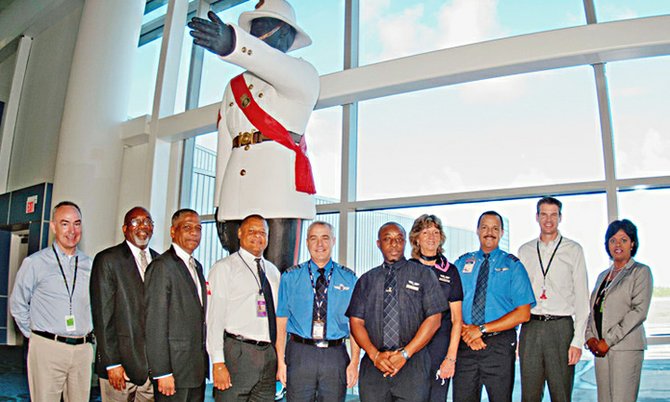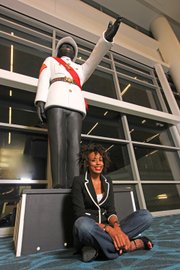By ALESHA CADET
Tribune Features Reporter
acadet@tribunemedia.net
IN THE International Arrivals Terminal at the Lynden Pindling Airport stands a 13ft high three-dimensional hand carved sculpture that some are calling a “must see”. Acting as a welcome sculpture to direct arriving passengers to the immigration hall, the piece known as the “Royal Welcome” has been received well since the opening of the new airport terminal, earlier this month.
The woman behind the creation of the piece, Keisha Oliver, is a self taught Bahamian artist who has been exhibiting work in the country, as well as the United Kingdom since 2003. For the most part, Ms Oliver said viewers are amazed at the size of the art piece. However, one of the first and more popular critiques she has personally received is “Boy he black aye.”
“I’ve become so accustomed to this response that naturally I begin to explain the reason behind his skin colour even before the overall concept. I chose to use the silhouette of a figure so that the focus would not be on the officer’s features, but more on what he is doing. I agree that the use of black is a strong colour choice, but this is symbolic in referencing the black also used in the Bahamian flag which represents the vigour and force of a united people,” said Ms Oliver.
Ms Oliver said upon receiving the news that her proposal was selected to be featured in the new airport terminal, she was completely shocked and thrilled.
“Even after successfully advancing to the second stage of the process, I was completely shocked with the news that my proposal had been selected. This was not because I had doubts, but it was a last minute idea that I only submitted on a whim the day before making my submission. This proved to me that sometimes the simplest ideas are the most profound,” said Ms Oliver.
Ms Oliver said the design proposal for the “Royal Welcome” was created in 2010, after she completed grad school. She then focused her research on information design. “At the time I was particularly interested in the role of way finding,” she said. Way finding is the art of using landmarks, singage, pathways and environmental cues to help first-time visitors navigate and experience a site without confusion, according to a design website.
“NAD’s proposed scheme described the site location as ‘the turning point, a major way finding event’. This not only served as the starting point of my research, but also became the focal point of my design proposal. I saw this project as an opportunity to create a piece of art that was functional whilst imbuing a Bahamian sense of place. I wanted to do this by using one of the most authoritative figures in Bahamian popular culture, a police traffic officer, as a directional figure,” said Ms Oliver. The sculpture depicts a Royal Bahamas Police Force Sergeant in ceremonial attire, greeting arriving passengers.
As a traditional traffic officer would direct motorists, Ms Oliver said this sculpture serves as the way finding landmark that directs international passengers.
“The fibreglass sculpture possesses a certain colloquial conservatism, suggestive of what many may consider classical Bahamian. The intention was to ensure that the functional aspects were satisfied, with the hope that the artistic and architectural beauty would naturally follow. The simplicity of the concept allows for passengers to immediately engage and relate to the piece with a single glance in this high traffic corridor,” said Ms Oliver.
Ms Oliver said she wanted to find a way to make a tribute to the police force, past and present, who are committed to making the Bahamas a safe and more pleasant place to live; work and visit. She said not only was this her first time working in this medium, but it was also her first sculpture of this scale. Ms Oliver said she approached it as a learning experience that she hoped would propel her career as a three dimensional artist.
“There were a few challenges mainly as the piece increased in size, which demanded additional manpower and resources. With the help of a dedicated fabrication and installation team, supportive friends, family and the resourceful staff of NAD and the officers of the Royal Bahamas Police Force, I was able to complete a piece we all as Bahamians can feel proud of,” said Ms Oliver.
She said this project has undoubtedly been a defining moment for her career, as a creative individual and a young Bahamian. She said more humbling, is the fact that she was one of the eleven artists chosen from over seventy five submissions. When speaking about the significance of airport art, Ms Oliver said: “In recent years airport art programmes like those of Atlanta, Denver and Vancouver international airports, have changed the nature of airports and the interconnection between people, art and architecture. They did this by transforming terminals into contemporary gallery spaces and by providing a glimpse of the creativity of artists.”
She said when NAD established LPIA’s art programme with the intentions of humanising the space with permanent art installations and rotating exhibitions by Bahamian artists, it definitely enhanced people’s appreciation for Bahamian art on an international platform.
“ Being one of the youngest commissioned artists along with Dede Brown who’s work will be featured in the Domestic Terminal, is motivating. I hope that our involvement inspires other young artists to never underestimate themselves or their creativity,” said Ms Oliver.






Comments
Use the comment form below to begin a discussion about this content.
Sign in to comment
Or login with:
OpenID